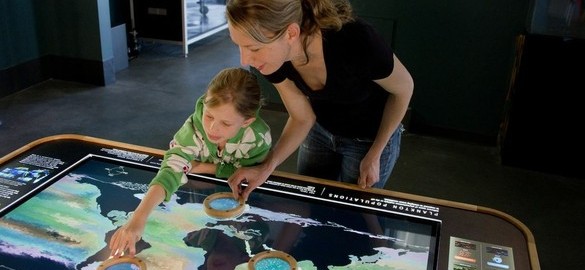For the past several months, Principal Research Scientist Stephanie Dutkiewicz and researcher Oliver Jahn have been consultants for staff at San Francisco’s Exploratorium science museum on the development of a new and exciting interactive exhibit designed to provide a hands-on experience with microscopic sea life.
In a hybrid of Darwin vizualisations with the museum’s traditional hands-on philosophy, staff at the museum have embedded interactive images of plankton distributions from the MIT project in a table-top, putting them in reach of small (and not so small) hands equipt with hand-held viewers for feasting on microscopic detail embedded in the exhibit.
The Exploratorium reopened Wednesday on a new nine-acre campus by the San Francisco Bay: Might be worth a visit next time you’re in town…
Below is an exerpt from In New Home, Exploratorium Widens Its Interactive Appeal (New York Times)
The potential can be seen clearly in a tabletop exhibit in the East Gallery, which focuses on living systems, that maps the world’s plankton species.
“We frame something that is always around you from the natural world and let you do the verbs of science — test, explore, observe,” said Jennifer Frazier, a cell biologist who is a staff scientist at the Exploratorium.
The availability of giant scientific data sets has proved to be both a challenge and an opportunity for the museum.
“It gives us access to a whole new phenomenon,” Dr. Frazier said, “and for me in particular it gives us access to a whole new scientific tool.”
Dr. Frazier came to the idea of observing the world’s plankton on a global scale while she was hunting for visualization information on even smaller life forms. While exploring the idea of an exhibit on the work that Craig Venter has done in charting the diversity of DNA in the world’s oceans, she learned about a Massachusetts Institute of Technology project that offered a vast plankton census.
The undertaking, known as the Darwin Project, is a giant supercomputer-based simulation of the world’s microscopic ocean life, which produces half the world’s oxygen and absorbs more carbon dioxide than all the forests on earth. This virtual ocean is based on sensor data from satellites and buoys. And with the help of scientific visualization experts at the University of California, Davis, the Exploratorium has translated that into an exhibit that is both visual and interactive.
The result is a “social” table that creates an experience that can be shared simultaneously by multiple viewers. Visitors can manipulate microscopelike rings that make it possible to peer into the virtual ocean and see the microscopic plankton.
“My first concern was that when people approached this, they would get an experience that felt like it belonged in the Exploratorium,” said Eric Socolofsky, one of the Exploratorium’s media designers. “Something like a big touch screen could be great, but it is a place where people are expecting to be engaging with things and operating things with their hands and their bodies and where they need tangible feedback. A touch screen by itself isn’t sufficient.”
